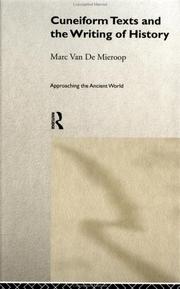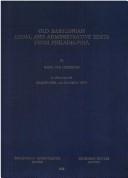| Listing 1 - 5 of 5 |
Sort by
|
Book
Year: 1966 Publisher: Louvain Institut orientaliste, Bibliothèque de l'Université Publications universitaires
Abstract | Keywords | Export | Availability | Bookmark
 Loading...
Loading...Choose an application
- Reference Manager
- EndNote
- RefWorks (Direct export to RefWorks)
Linguistique --- Taalkunde --- Babylonien [Langue] --- Babylonisch --- 492.15-4
Book
Year: 1984 Publisher: Rome Biblical Institute Press
Abstract | Keywords | Export | Availability | Bookmark
 Loading...
Loading...Choose an application
- Reference Manager
- EndNote
- RefWorks (Direct export to RefWorks)
Book
ISBN: 1575068931 9781575068930 9781575062808 1575062801 Year: 2021 Publisher: University Park, PA
Abstract | Keywords | Export | Availability | Bookmark
 Loading...
Loading...Choose an application
- Reference Manager
- EndNote
- RefWorks (Direct export to RefWorks)
Hittite culture of the second millennium B.C.E. was strongly influenced by Mesopotamian culture, in part through the mediation of the peripheral cuneiform civilizations of northern Syria, in part through direct contact with Babylonia and Assyria. The text edited here (CTH 718) presents an extreme example of this cultural impact, featuring incantations in the Akkadian language (Hittite babilili) embedded within a ceremony set forth in the Hittite tongue. This ritual program has therefore become known to scholars as the "babilili-ritual." With almost 400 preserved lines, this ceremony is one of the longest religious compositions recovered from the Hittite capital, and there are indications that a significant additional portion has been lost. The divine figure to whom the rite is addressed is Pirinkir, a variety of the well-known Ishtar of Mesopotamia. Its purpose seems to be the elimination of the sins of a member of the royal family. Many of the ritual activities and offering materials employed here are characteristic of the cult practice of the Classical Cilician region known as Kizzuwatna, which was introduced into the central Hittite realm during the final two centuries of the state's existence. Nonetheless, the Akkadian of the incantations is neither the Akkadian employed in the Hurrian-influenced area of Syria and eastern Anatolia nor that otherwise known from the Hittite royal archives; rather, it is closer to the language of the later Old Babylonian period, even if no precise Mesopotamian forerunners can yet be identified.
Hittites --- Akkadian language --- Religion. --- Kizzuwatna (Cilicia) --- Akkadian language. --- Akkadien (langue) --- Religion hittite. --- Accadian language --- Assyrian language --- Assyro-Babylonian language --- Babylonian language --- Semitic languages --- Religion, Primitive --- Atheism --- Irreligion --- Religions --- Theology --- Textes. --- Texts. --- Kizzuwatna (royaume) --- Histoire --- Sources. --- Mythologie hittite --- Temples hittites --- Dieux hittites --- Accadien (langue) --- Assyrien (langue) --- Assyro-babylonien (langue) --- Babylonien (langue) --- Sémitique oriental (langue) --- Akkadien --- Correspondance akkadienne --- Dictionnaires akkadiens --- Emprunts akkadiens --- Glossaires et lexiques akkadiens --- Grammaire comparée --- Hymnes akkadiens --- Incantations akkadiennes --- Incantations assyro-babyloniennes --- Inscriptions akkadiennes --- Littérature assyro-babylonienne --- Noms de personnes akkadiens --- Noms géographiques akkadiens --- Philologie akkadienne --- Langues sémitiques --- Religion --- langue) -- Vocabulaire --- Kizzuwadna (Royaume) --- Kizzuwatna (Royaume) --- Asie Mineure --- Kizzuwatna (Kingdom)

ISBN: 0415195330 0415195322 9780415195324 Year: 1999 Volume: 6 Publisher: London: Routledge,
Abstract | Keywords | Export | Availability | Bookmark
 Loading...
Loading...Choose an application
- Reference Manager
- EndNote
- RefWorks (Direct export to RefWorks)
History as a science --- Ancient history --- Iraq --- Assyrisch-Babylonisch (Taal) -- Teksten --- Assyrisch-Babylonische teksten --- Assyro-Babylonian inscriptions --- Assyro-Babylonian language -- Texts --- Assyro-Babylonian texts --- Assyro-babylonien (Langue) -- Textes --- Cuneiform inscriptions --- Cuneiform tablets --- Inscripties in spijkerschrift --- Inscriptions [Assyrian] --- Inscriptions [Babylonian] --- Inscriptions [Behistun] --- Inscriptions [Cuneiform] --- Inscriptions assyriennnes --- Inscriptions babyloniennes --- Inscriptions cunéiformes --- Kleitabletten met spijkerschrift --- Opschriften [Assyrische ] --- Opschriften [Babylonische ] --- Opschriften in spijkerschrift --- Spijkerschrifttabletten --- Tablets [Cuneiform ] --- Tabletten [Spijkerschrift] --- Tablettes cunéiformes --- Textes assyro-babyloniens --- Cuneiform tablets. --- Cuneiform inscriptions. --- Irak --- History --- Sources. --- Histoire --- Sources --- Historiography --- Historiography. --- Tablettes cunéiformes --- Inscriptions cunéiformes --- Tablets, Cuneiform --- Clay tablets --- Cuneiform writing --- Inscriptions, Cuneiform --- Assyro-Babylonian literature --- Civilization, Assyro-Babylonian --- Achaemenian inscriptions --- Old Persian inscriptions --- Rāfidayn, Bilād --- Bilād al-Rāfidayn --- Republic of Iraq --- Jumhuriyah al Iraqiyah --- To 634 --- Iraq - History - To 634 - Sources --- Iraq - History - To 634 - Historiography

ISBN: 9068310631 9789068310634 Year: 1986 Volume: 21 Publisher: Leuven: KUL. Departement oriëntalistiek,
Abstract | Keywords | Export | Availability | Bookmark
 Loading...
Loading...Choose an application
- Reference Manager
- EndNote
- RefWorks (Direct export to RefWorks)
History of the law --- Manuscripts. Epigraphy. Paleography --- Antiquity --- Assyria, Babylonia, Mesopotamia --- Geschiedenis van de Oudheid --- Histoire de l'Antiquité --- Historische bronnen --- Sources historiques --- Akkadian language --- Law --- Texts --- Sources --- Babylonia --- Sippar (Extinct city) --- Politics and government --- -Law --- -Academic collection --- Acts, Legislative --- Enactments, Legislative --- Laws (Statutes) --- Legislative acts --- Legislative enactments --- Jurisprudence --- Legislation --- Accadian language --- Assyrian language --- Assyro-Babylonian language --- Babylonian language --- Semitic languages --- -Sippar (Extinct city) --- Abu Habba Site (Iraq) --- Abū Ḥabbah Site (Iraq) --- Sippar (Ancient city) --- Iraq --- -Sources --- Antiquities --- Texts. --- Sources. --- Vavilonii︠a︡ --- Bavel --- Bābil --- Babylonien --- Academic collection --- Sumer --- Babylonië. Geschiedenis. (Bronnen) --- Assyro-babylonien [Langue]. Textes. --- Babylonie. Histoire. (Sources) --- Assyrisch-Babylonisch. Teksten. --- Linguisten, historici --- Akkadian language - Texts --- Law - Iraq - Babylonia - Sources --- Babylonia - Politics and government - Sources
| Listing 1 - 5 of 5 |
Sort by
|

 Search
Search Feedback
Feedback About UniCat
About UniCat  Help
Help News
News